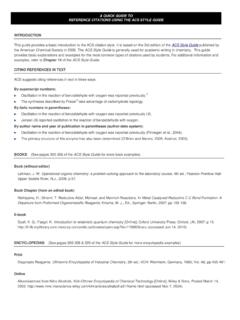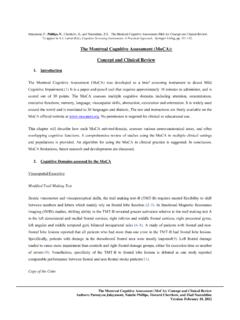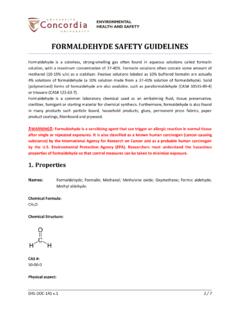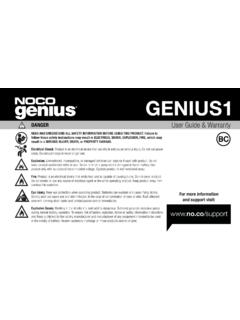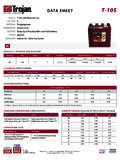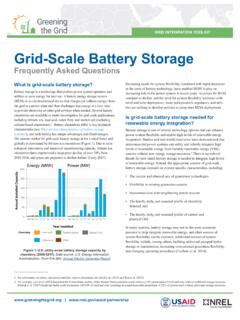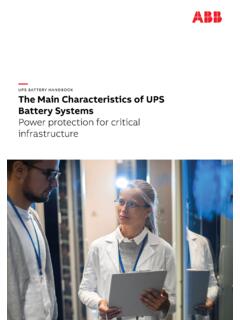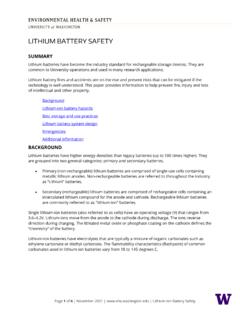Transcription of LEAD ACID BATTERIES - Concordia University
1 EHS-DOC-146 1 / 18 LEAD acid BATTERIES 1. Introduction Lead acid BATTERIES are the most common large-capacity rechargeable BATTERIES . They are very popular because they are dependable and inexpensive on a cost-per-watt base. There are few other BATTERIES that deliver bulk power as cheaply as lead acid , and this makes the battery cost-effective for automobiles, electrical vehicles, forklifts, marine and uninterruptible power supplies (UPS). Lead acid BATTERIES are built with a number of individual cells containing layers of lead alloy plates immersed in an electrolyte solution, typically made of 35% sulphuric acid (H2SO4) and 65% water (Figure 1). Pure lead (Pb) is too soft and would not support itself, so small quantities of other metals are added to get the mechanical strength and improve electrical properties.
2 The most common additives are antimony (Sb), calcium (Ca), tin (Sn) and selenium (Se). When the sulphuric acid comes into contact with the lead plate, a chemical reaction is occurring and energy is produced. Figure 1: Typical lead acid battery schematic Lead acid BATTERIES are heavy and less durable than nickel (Ni) and lithium (Li) based systems when deep cycled or discharged (using most of their capacity). Lead acid BATTERIES have a moderate life span and the charge retention is best among rechargeable BATTERIES . The lead acid battery works well at cold temperatures and is superior to lithium-ion when operating in sub-zero conditions. Lead acid BATTERIES can be divided into two main classes: vented lead acid BATTERIES (spillable) and valve regulated lead acid (VRLA) BATTERIES (sealed or non-spillable).
3 EHS-DOC-146 2 / 18 2. Vented Lead acid BATTERIES Hazards Vented lead acid BATTERIES are commonly called flooded , spillable or wet cell BATTERIES because of their conspicuous use of liquid electrolyte (Figure 2). These BATTERIES have a negative and a positive terminal on their top or sides along with vent caps on their top. The purpose of the vent caps is to allow for the escape of gases formed, hydrogen and oxygen, when the battery is charging. During normal operation, water is lost due to evaporation. In addition, the vent caps allow water and acid levels of the battery to be checked during maintenance. Figure 2: Typical vented lead acid battery schematic The main hazards associated with lead acid BATTERIES are: 1) Chemical (corrosive) hazards 2) Risk of fire or explosion 3) Electrical shocks 4) Ergonomic hazards related to their heavy weight 5) Transportation hazards acid burns to the face and eyes comprise about 50% of injuries related to the use of lead acid BATTERIES .
4 The remaining injuries were mostly due to lifting or dropping BATTERIES as they are quite heavy. Chemical Hazards Sulphuric acid Lead acid BATTERIES are usually filled with an electrolyte solution containing sulphuric acid . This is a very corrosive chemical (pH<2) which can permanently damage the eyes and produce serious chemical burns to the skin. Sulphuric acid is also poisonous, if swallowed. The lead alloys found in BATTERIES are also harmful to humans and can also seriously damage the environment. When working with battery acid , the following precautions must be taken: EHS-DOC-146 3 / 18 Wear the proper personal protective equipment (PPE), specifically splash-proof goggles, acid -resistant lab coat or apron, safety shoes and rubber gloves. A face shield must also be worn when refilling BATTERIES with electrolytes.
5 Know where the emergency showers and emergency eyewash stations are located; they must be located near lead acid battery storage and charging areas. Slowly pour concentrated acid into water; do not add water to acid . (warning: electrolyte will become hot; do not close battery vents until electrolyte has cooled down) Use non-metallic containers and funnels. Ensure neutralizers ( baking soda) are available for immediate use. Use extreme care to avoid spilling or splashing the sulphuric acid solution Table 1: Characteristics lead acid battery electrolyte (35% H2SO4 / 65% water) Health Risks (WHMIS 2015) color clear odor sharp, pungent pH 1 to 2 Boiling point 95-115 C LC50 (rat) 375 mg/m3 LD50 (oral, rat) 2140 mg/kg Electrolyte Spill In the event of a minor electrolyte spill (Figure 3), consult the appropriate Safety Data Sheet (SDS) for electrolyte spill containment, clean-up and disposal details.
6 Always ensure to wear adequate protective clothing (goggles, closed shoes and gloves) during clean-up of spills. In case of a small electrolyte spilled, you should: Contain the spill with absorbents such as universal pads, hazmat pads, sand, earth or vermiculite. Remove the absorbents once it has soaked up the acid /electrolyte. Clean up spilled acid safely with an acid neutralizer and then with large volumes of water to rinse the area. Safely dispose of any contaminated material as chemical waste by contacting Advise your supervisor and complete an Injury / Near-Miss Report (EHS-FORM-042). In the event of a large acid electrolyte spill: 1. Advise and warn co-workers. 2. Evacuate the area immediately. 3. Restrict the access to the area. 4. Notify Security at X3717 or (514) 848-3717, providing them with the following information: EHS-DOC-146 4 / 18 a.
7 Location of the spill b. Name of hazardous material c. Quantity involved d. Related health risks and precautions to be taken 5. Provide the Safety Data Sheets (SDS) or appropriate documentation. Figure 3: Picking up a small battery electrolyte spill First-Aid Measures In the event of exposure with sulphuric acid , Security must be immediately contacted at X3717. Following an exposure, an Injury/Near-Miss Report (EHS-FORM-042) must be sent to EHS. i. Contact with skin Flush the contaminated area, as quickly as possible, with gently flowing lukewarm water for at least 30 minutes; if any irritation persists, repeat flushing Under running water, remove contaminated clothing, shoes and other leather goods ( , watchbands, belts); discard any contaminated clothing, shoes, etc. Seek medical treatment if required.
8 Ii. Contact with eyes Immediately flush the contaminated eye(s) with gently flowing lukewarm water for at least 30 minutes while holding the eyelid(s) open. If any irritation persists, repeat flushing and seek medical treatment immediately Bad Odors Over-charging a vented lead acid battery can produce hydrogen sulfide (H2S). The gas is colorless, very poisonous, flammable and has the odor of rotten eggs. Being heavier than air, the gas accumulates at the bottom of poorly ventilated spaces. Although noticeable at first (olfactory detection between ppm), the sense of smell deadens the sensation with time and potential victims may be unaware of its presence. When the odor is detected, one must turn off the charger, vent the facility and stay outside until the odor disappears. Refer to Section for proper charging safety tips.
9 EHS-DOC-146 5 / 18 Fire & Explosion Hazards Hydrogen Gas Vented lead acid BATTERIES vent little or no gas during discharge. However, when they are being charged, they can produce explosive mixtures of hydrogen (H2) and oxygen (O2) gases, which often contain a mist of sulphuric acid . Hydrogen gas is colorless, odorless, lighter than air and highly flammable. Oxygen is an oxidizer than can promote the burning or explosion of flammable and combustible materials. The mixture of two parts hydrogen to one part oxygen produced is perfect for an explosion. If area ventilation is poor or the charging BATTERIES enclosed, the escaping hydrogen creates an explosive atmosphere around the battery . In sealed rooms with poor ventilation, hydrogen may accumulate near the ceiling. Hydrogen must not be allowed to accumulate in concentrations greater than 1% of the volume of air in a space (the lower explosive limit [LEL] for hydrogen is 4% and the upper explosive limit [UEL] is 75%).
10 A hydrogen (H2) detector (Figure 4) at ceiling level must be installed in rooms where vented acid lead BATTERIES are being charged. Figure 4: Different types of hydrogen detectors storage Stored lead acid BATTERIES create no heat. High ambient temperatures will shorten the storage life of all lead acid BATTERIES . Vented lead acid BATTERIES would normally be stored with shipping (protecting) plugs installed, in which case they release no gas. With shipping plugs removed, vented lead acid BATTERIES can give off minor amounts of hydrogen and oxygen due to normal evaporation of water, depending upon the amount of ambient heat and air humidity. Vented lead acid BATTERIES should be installed in dedicated battery rooms, but may share the same room as the equipment they support (such as a UPS system). Such rooms must be physically separated from other areas, devoid of localized heat sources and have doors and/or partitions designed to meet the required fire resistance rating for the application.
